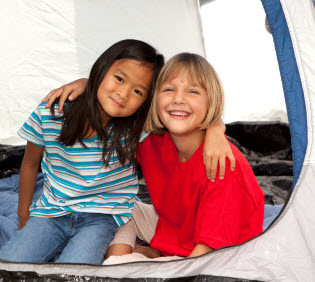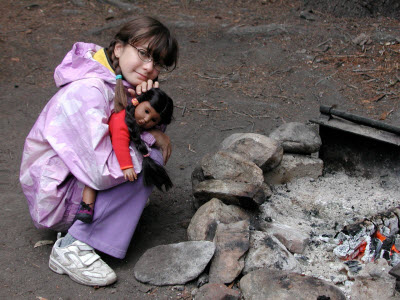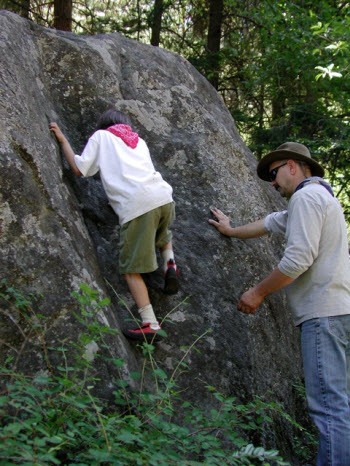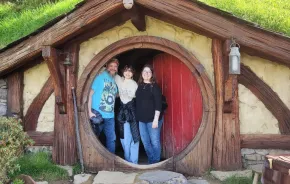 Here in the land of REI, we may think camping is in our DNA, but even experienced campers can be at a loss once they become parents. The activities that delight adults may seem boring or arduous to a 5-year-old.
Here in the land of REI, we may think camping is in our DNA, but even experienced campers can be at a loss once they become parents. The activities that delight adults may seem boring or arduous to a 5-year-old.
But there are plenty of reasons to opt for a family camping trip. It’s cheap compared to a vacation that involves airfare and lodging and most kids love being outdoors. It’s also the perfect option when you only have a few days to spend. The trick is to plan ahead.
My husband and I were seasoned campers and backpackers (we honeymooned in a tent in Yosemite), but our approach changed after our daughter was born and continues to evolve. Though hard-core enthusiasts advocate backpacking with babies, we found that camping with a child still in diapers to be less than fun. Keeping an eagle eye on a toddler around the obvious dangers of a campsite added stress to what should be a relaxing commune with nature, so we opted for day trips until she was about four.
Even then, our past experience was only so valuable; in many ways we were novices now that a small child was in the mix. Everything — where to go, what to bring, what to do — had to be considered from her perspective. Isolation and long hikes were no longer priorities. Playgrounds and water were. Here are some of the key lessons about car camping with kids we’ve learned through trial and error over the years.
Where to go
Puget Sound residents are blessed with a plethora of wonderful camping experiences that can be reached by car in less than four hours. Sites for car camping are available in Washington State Parks, National Forests and various county parks, and are easy to find on the Internet. (See related article “5 Great Campgrounds for Kids in Washington State.”) Some allow you to make reservations well in advance — which is best. It’s no fun driving around trying to find an open campsite under the best of circumstances, but especially not with a road-weary child in the car.
Do your campground research – they can differ radically. Many have playgrounds, but there are no standards so supervised use is smart. Bikes are usually allowed on paved areas, though I’d stress caution in letting your little one ride around alone. Amenities will vary from rustic (pit toilets) to plush (bathrooms with flush toilets, hot water and coin-operated showers), so it’s important to check through the campground’s website carefully — and know what you and your kid(s) can bear. Many sites, but not all, have picnic tables and fire pits or grills. Some campgrounds require you to bring your own water. We found that a 5-gallon container brought from home could last the weekend as long as we supplemented with a couple of jugs of drinking water.
A camp-side stream or lake can be lovely, unless your child is prone to dashing off on their own (mine was). Ditto for a site that’s close to the main road. Most websites allow you to look at a campground layout to pick the perfect spot.
Weather can be a determining factor. In the late spring and early fall, it’s often warmer and drier east of the mountains — but there are snakes on that side, too! Summer months are usually safe no matter where you go, though never head out without your rain gear.
What to bring
Though we had tons of gear for ourselves, when we started camping with our daughter in tow, we had to make some changes, including get a bigger tent. If you’re new to camping, rent or borrow from savvy friends at first to see if you like it. REI offers rental of the basic gear (tents, sleeping bags/pads, stoves) at most of its Washington stores. Whatever you do, make sure your tent is of high quality and has a rainfly that covers it to the ground. (See related article: “The Essential Car Camping Packing List”) for of must-have gear to make your camping experience comfortable and enjoyable.
When it comes to clothes, take a tip from the Boy Scouts and “be prepared” for anything. Consider the Northwest mantra “dress in layers.” Rain gear should be breathable (not plastic coated) and footwear sturdy. Skimpy sandals and patent leather should be left at home. Warm days can turn into cold nights, so be sure to pack a hat and gloves.
 Creating a kid-friendly campsite
Creating a kid-friendly campsite
Most kids take to the outdoors like baby ducks to a pond, but even the most adventurous needs some down time. It’s important to bring along some things to do around the campsite while mom and dad are busy setting up the tent or cooking meals. -
Create a designated play space within your line of vision, but away from the campfire, with a blanket or tarp. -
Bring toys and activities that can handle a little dirt and don’t have a lot of tiny pieces. My daughter loved bringing a few plastic horses (Breyers are great). She would gather twigs to create paddocks and corrals, and grass for hay. Trucks and blocks are also good options. -
A small whiteboard and dry erase markers eliminate the need for lots of paper. Books that your child can “read” on their own are a must. -
“New” toys are also great for their novelty factor—I’d hit Value Village for inexpensive options. Keep electronics to a minimum; save them for the car ride or in the event that rain or mosquitoes keep you tent-bound for a while. And never underestimate the value of a deck of cards!
As for bedtime success: We always tried to stick to as much of our normal bedtime routine as possible when camping. In lieu of a bath, we’d wash up with warm water from the campstove, change into jammies and settle down in the tent for a bedtime story. If your child sleeps with a favorite blankie or special stuffed toy, don’t forget it. When my child was very young, I sang lullabies, too. Amazingly, she managed to fall asleep and stay asleep despite her father’s snoring!
What to eat
Food should be simple to prepare and something you know your child will eat. Now is not the time to try a fancy recipe or introduce new foods. If your kid eats oatmeal for breakfast, stick with that and skip the eggs and hash browns. Packable snacks like nuts and sesame sticks are great for hikes. Chocolate is a high-energy treat, but it melts in warm weather, so we keep ours in the cooler. Hot dogs and burgers are always a hit if your campsite has a grill — some do. Mac n’ cheese and spaghetti cook easily on a campstove, though require a bit more clean-up. You can’t always count on a campfire, as burn bans can be in affect during dry summer months, so check before you go if you have your heart set on s’mores.
What to do
Save the 5-mile hikes with numerous switchbacks for when your children are older. The nuances of wildflowers along a trail can hold a four-year-old’s attention for only so long. A shorter hike almost guarantees less whining and prevents a meltdown at the end.
There’s often plenty to explore around the campground. Invest in some kid-friendly guidebooks (Amazon is a good source) and try to identify the rocks, birds, bugs, flowers and trees you see. Invest in a pair of binoculars, and bring along a magnifying glass. If your campground has access to water — a lake, stream, river, or shore — even better! Swimming and boating are always fun; be sure to come prepared with life vests, towels and plenty of sunscreen.
And there’s nighttime: Though summer nights are long, darkness will fall and activities adjust. Sing or tell stories around the campfire or in the tent by lantern light. Slightly older kids can be introduced to the wonders of the night sky -- you don’t need a telescope to see constellations like Orion. Our daughter liked it when we told round-robin stories while lying in our sleeping bags. One person told a leg of the story, ending with “and then…,” which was picked up by the next until we drifted off to sleep.
But sometimes even the most beautiful setting can’t keep your child’s attention all day. Where we were content to spend the entire day immersed in nature, she wanted to go, and see and do! We found, through trial and error, that our best experiences when she was little were at campgrounds that were in close proximity to other attractions.
The town of Sequim on the Olympic Peninsula is a perfect example. It has a variety of campgrounds within a ten-minute drive of the city center. On our first trip there, we were met with uncharacteristic rain (it’s in the rain shadow and is normally dry). To our delight, the Sequim Aquatic Center was open to the public for a nominal fee. We spent an afternoon swimming in the terrific pool — complete with water slide and rope swing. My hubby and I even took turns relaxing in the sauna and Jacuzzi. A drive through the Olympic Game Farm was fun for all, and made for great photo ops. Once the rain let up, we walked the five-mile beach of the Dungeness Spit, just north of Sequim. It had everything a kid could want: water, driftwood, rocks, seagulls, and shells. The next day, we found a wonderful playground at Margaret Kiner Park — all this within 20 minutes of our campsite.
The point is to have fun. You don’t have to rough it. Even though the natural setting is the main reason to go camping, we found that the ability to take a break from the wild and get an ice cream or visit a roadside attraction made all the difference to keeping our child happy for the duration of the trip. And the opportunity to use a flush toilet and wash up with hot water doesn’t hurt either. The good news is that there are no “camping police” who will chastise you for bringing an air mattress or heading into town for a meal.
Happy car camping!
Andrea Leigh Ptak is a Seattle-based freelance writer who has camped extensively with her family across the Western United States.
10 essentials for car camping with kids in the Pacific Northwest
The Mountaineers’ list of essentials is fine for adults, but if you’re bringing kids along, be sure to pack these things, too.
1. Sunscreen
2. Deck of cards
3. Flashlight
4. Wet wipes
5. Bedtime “lovey”
6. Flip flops
7. Art supplies
8. Magnifying glass
9. Healthy snacks
10. Books and toys
For more tips on car camping, see these related articles:









